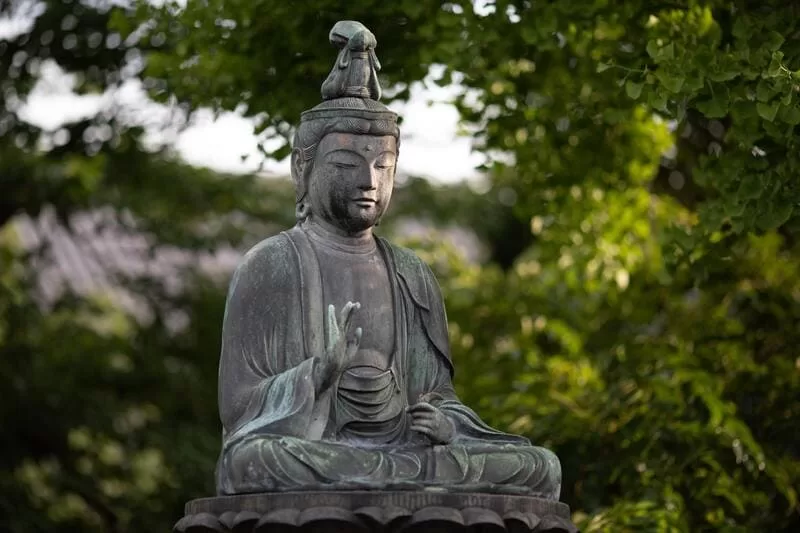Founded over 2,500 years ago in India by Siddhartha Gautama, Buddhism is an ancient and profound philosophy that offers a pathway to inner peace, wisdom, and self-awareness. Buddhism emerged in South Asia around the 5th century B.C.E. and over the next millennia it spread across Asia and the rest of the world.
The term “Buddha” means “enlightened one”, and he is considered the awakened or enlightened teacher who shared his insights to help others end suffering and attain liberation. Contrary to popular belief, Buddhists believe that anyone can become a Buddha.
This article will explore the fundamental principles of Buddhism and also some facts about Buddhism.
Central to its teachings are the Four Noble Truths, which address the nature of suffering and the path to liberation:
a) The truth of suffering: Life inherently involves suffering, which includes physical and mental pain, dissatisfaction, and impermanence.
b) The truth of the origin of suffering: This suffering arises from attachment, desire, and ignorance.
c) The truth of the cessation of suffering: By eliminating attachment and desires, it is possible to attain liberation and inner peace.
d) The truth of the path to the cessation of suffering: The Noble Eightfold Path, which includes ethical conduct, mental discipline, and wisdom, serves as the guide to overcoming suffering and achieving enlightenment.
Here Are Some Interesting Facts About Buddhism

1. Enlightenment Under the Bodhi Tree: Siddhartha Gautama attained enlightenment while meditating under the Bodhi Tree in Bodh Gaya, India. He realized the Four Noble Truths and became the Buddha.
2. Ashoka the Great: Emperor Ashoka (c. 268–232 BCE) was a powerful Indian ruler who embraced Buddhism after witnessing the devastation of a war he started. He promoted non-violence, dharma (which refers to the teachings of the Buddha, the path to enlightenment, and the natural order or law that governs the universe), and sent Buddhist missionaries to spread the teachings far beyond India’s borders.
3. The Tripitaka: The Tripitaka, also known as the Pali Canon, is the oldest and most complete collection of Buddhist scriptures. It is written in Pali and contains teachings attributed to the Buddha.
4. Nirvana and Samsara: In Buddhism, Nirvana is the state of liberation from the cycle of birth, death, and rebirth (Samsara). It represents the cessation of suffering and ignorance.
5. The Three Marks of Existence: Buddhism teaches the Three Marks of Existence: Anicca (impermanence), Dukkha (suffering), and Anatta (no-self). These principles highlight the impermanent, unsatisfactory, and interconnected nature of reality and the human condition. By understanding these concepts, individuals can cultivate wisdom, compassion, and detachment, ultimately leading to liberation from suffering (Nirvana) and a deeper sense of inner peace and contentment.
6. Vesak or Buddha Purnima: Vesak is one of the most important Buddhist festivals, celebrating the birth, enlightenment, and death of the Buddha. It is observed in various countries on different dates. One interesting fact is that there are no specific dates for Buddhist festivals.
The exact dates and practices may vary depending on cultural traditions and local customs. Vesak, for example, is celebrated on the full moon day in May or June, according to the lunar calendar. Other such festivals follow a similar pattern.
7. Buddhist Symbols: The Dharma Wheel (Dharmachakra) and the Lotus Flower are significant symbols representing the teachings and enlightenment in Buddhism. In total there are 8 symbols that buddhists consider very auspicious.

8. Buddhism and Science: Modern scientific research has shown interest in Buddhist practices like meditation, which have been found to have various physical and mental health benefits.
9. Lumbini: Lumbini in Nepal is the birthplace of Siddhartha Gautama and a UNESCO World Heritage Site.

10. Monastic Communities: Monks and nuns play a vital role in preserving and practicing Buddhism. They lead lives of hermits, focusing on spiritual growth and sharing teachings with laypeople.
11. Metta (Loving-Kindness): Metta is a practice of cultivating unconditional love and benevolence towards all living beings, a central aspect of Buddhist ethics.
12. Buddhism in the West: Buddhism has gained popularity in the West, with many individuals adopting its practices and philosophies to enhance well-being and find meaning in life.
13. Karma and Intention: Buddhism emphasizes that the intention behind an action is more critical than the action itself. Positive intentions lead to positive karma.
14. Dalai Lama: The Dalai Lama is the spiritual leader of Tibetan Buddhism, believed to be the reincarnation of previous Dalai Lamas. The Dalai Lama’s selection process has a rich history that dates back several centuries. The method used to choose the Dalai Lama involves a combination of religious traditions and mystical beliefs.
According to belief, the Dalai Lamas are believed to be incarnations of Avalokitesvara, the bodhisattva of compassion. Across six centuries, the 14 lineages of Dalai Lamas are connected through their displays of compassion.
15. Branches of Buddhism: Buddhism has three major branches in the modern world. They are Mahayana Buddhism, Theravada Buddhism and Vajrayana Buddhism which is sometimes also referred to as Tibetan Buddhism.
Mahayana Buddhism is considered to be the largest branch of Buddhism, primarily due to its prevalence in several countries with significant Buddhist populations, including China, Japan, South Korea, and Vietnam. Theravada Buddhism being the second-largest branch and Vajrayana Buddhism being the third respectively.
These facts about Buddhism provide a deeper insight into the beliefs, history, and impact of Buddhism, a profound and enduring spiritual tradition that continues to inspire seekers of wisdom and inner peace worldwide.
The Power of Buddhist Meditation

Meditation plays a central role in Buddhist practice, serving as a powerful tool for self-discovery and transformation. Through various techniques such as breath awareness, loving-kindness meditation, and vipassana (insight) meditation, practitioners learn to quiet their minds and tap into their innate wisdom.
One significant aspect of Buddhist meditation is mindfulness – a state of non-judgmental awareness in which individuals observe their thoughts, emotions, and sensations without attachment or aversion. By cultivating mindfulness through regular practice, Buddhists develop greater clarity, emotional resilience, and a heightened sense of presence in their daily lives.
In conclusion, Buddhism, with its profound teachings and diverse traditions, continues to captivate the hearts and minds of millions worldwide. From the spiritual guidance of the Dalai Lama to the transformative power of meditation and mindfulness, Buddhism continues to inspire and impact lives. The symbolic representations like the Dharma Wheel and the Lotus Flower serve as constant reminders of its timeless teachings.
The Next Step
As we reach the end of this enlightening journey, we hope that these facts about Buddhism inspire you to embrace the path of wisdom, compassion, and self-discovery. Just as the historical Buddha once illuminated his surroundings with the light of enlightenment, may you too find illumination and purpose in your pursuit of understanding and inner peace.
The founder of Samavira, Lauren is trained by Buddhist Monks while living in a monastery in Thailand. Would you like to experience Samavira’s guided meditations? Sign up for free!







